|
PLearn 0.1
|
|
PLearn 0.1
|
#include <VPLPreprocessedLearner2.h>
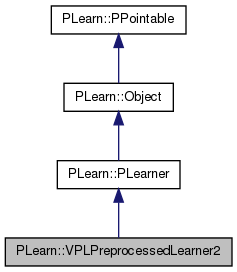
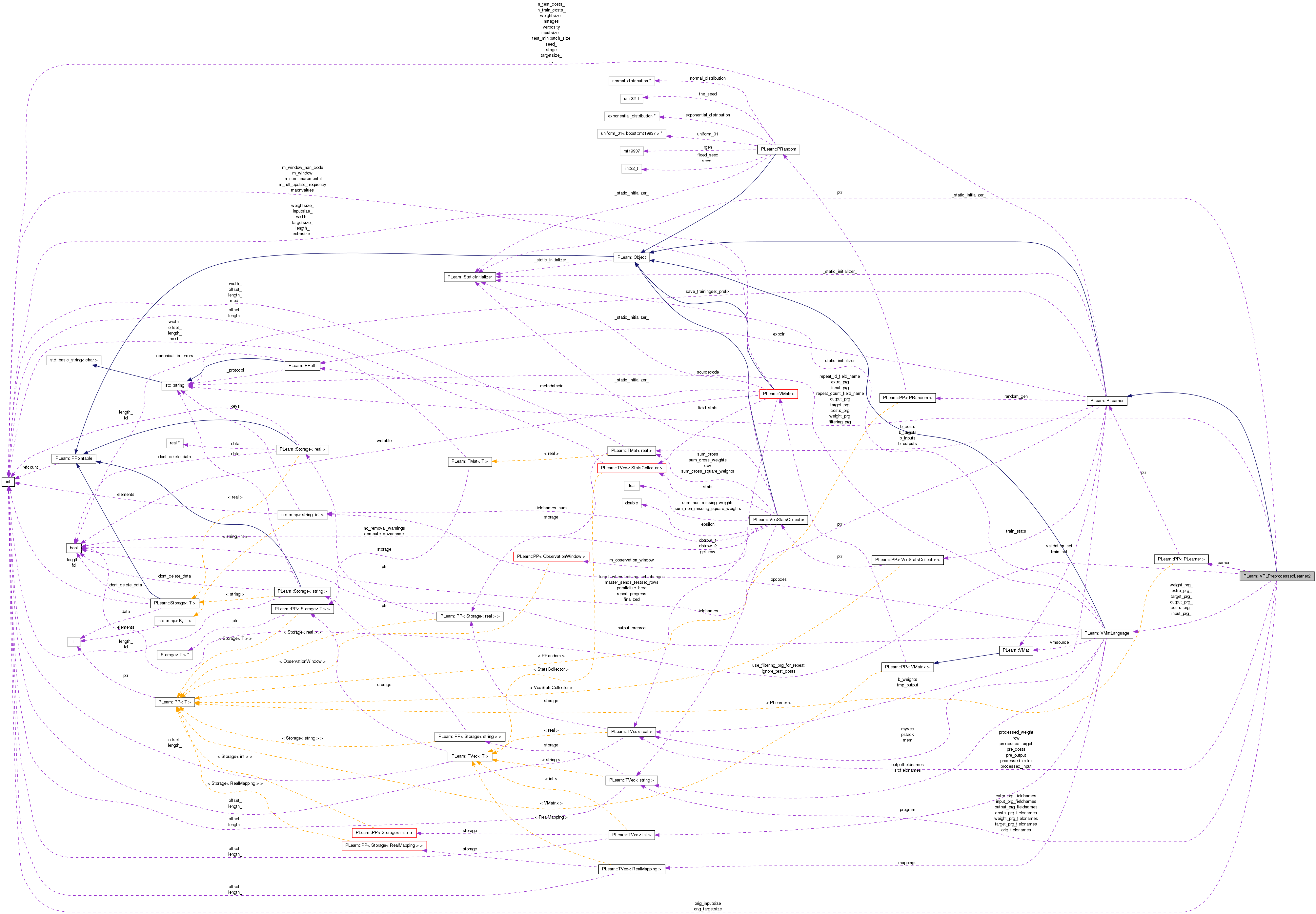
Public Member Functions | |
| VPLPreprocessedLearner2 () | |
| Default constructor. | |
| virtual void | build () |
| Simply calls inherited::build() then build_(). | |
| virtual void | makeDeepCopyFromShallowCopy (CopiesMap &copies) |
| Transforms a shallow copy into a deep copy. | |
| virtual string | classname () const |
| virtual OptionList & | getOptionList () const |
| virtual OptionMap & | getOptionMap () const |
| virtual RemoteMethodMap & | getRemoteMethodMap () const |
| virtual VPLPreprocessedLearner2 * | deepCopy (CopiesMap &copies) const |
| virtual int | outputsize () const |
| SUBCLASS WRITING: override this so that it returns the size of this learner's output, as a function of its inputsize(), targetsize() and set options. | |
| virtual void | setValidationSet (VMat validset) |
| Forwarded to inner learner. | |
| virtual void | setTrainStatsCollector (PP< VecStatsCollector > statscol) |
| Forwarded to inner learner. | |
| virtual void | setExperimentDirectory (const PPath &the_expdir) |
| Forwarded to inner learner. | |
| virtual void | forget () |
| Forwarded to inner learner. | |
| virtual void | setTrainingSet (VMat training_set, bool call_forget=true) |
| Declares the training set. | |
| virtual void | train () |
| *** SUBCLASS WRITING: *** | |
| virtual void | computeOutput (const Vec &input, Vec &output) const |
| *** SUBCLASS WRITING: *** | |
| virtual void | computeOutputAndCosts (const Vec &input, const Vec &target, Vec &output, Vec &costs) const |
| Default calls computeOutput and computeCostsFromOutputs. | |
| virtual void | computeCostsFromOutputs (const Vec &input, const Vec &output, const Vec &target, Vec &costs) const |
| *** SUBCLASS WRITING: *** | |
| virtual bool | computeConfidenceFromOutput (const Vec &input, const Vec &output, real probability, TVec< pair< real, real > > &intervals) const |
| Compute a confidence intervals for the output, given the input and the pre-computed output (resulting from computeOutput or similar). | |
| virtual TVec< string > | getOutputNames () const |
| If there's an output_prg, it returns output_prg_fieldnames If there's no output_prg, the call is forwarded to the inner learner. | |
| virtual TVec< std::string > | getTestCostNames () const |
| *** SUBCLASS WRITING: *** | |
| virtual TVec< string > | getTrainCostNames () const |
| Forwarded to inner learner. | |
| virtual void | resetInternalState () |
| Forwarded to inner learner. | |
| virtual bool | isStatefulLearner () const |
| Forwarded to inner learner. | |
Static Public Member Functions | |
| static string | _classname_ () |
| static OptionList & | _getOptionList_ () |
| static RemoteMethodMap & | _getRemoteMethodMap_ () |
| static Object * | _new_instance_for_typemap_ () |
| static bool | _isa_ (const Object *o) |
| static void | _static_initialize_ () |
| static const PPath & | declaringFile () |
Public Attributes | |
| PP< PLearner > | learner_ |
| Inner learner which is embedded into the current learner. | |
| string | filtering_prg |
| string | input_prg |
| string | target_prg |
| string | weight_prg |
| string | extra_prg |
| string | output_prg |
| string | costs_prg |
Static Public Attributes | |
| static StaticInitializer | _static_initializer_ |
Static Protected Member Functions | |
| static void | declareOptions (OptionList &ol) |
| Declares this class' options. | |
Protected Attributes | |
| VMatLanguage | input_prg_ |
| VMatLanguage | target_prg_ |
| VMatLanguage | weight_prg_ |
| VMatLanguage | extra_prg_ |
| VMatLanguage | output_prg_ |
| VMatLanguage | costs_prg_ |
| TVec< string > | input_prg_fieldnames |
| TVec< string > | target_prg_fieldnames |
| TVec< string > | weight_prg_fieldnames |
| TVec< string > | extra_prg_fieldnames |
| TVec< string > | output_prg_fieldnames |
| TVec< string > | costs_prg_fieldnames |
| Vec | row |
| Vec | processed_input |
| Vec | processed_target |
| Vec | processed_weight |
| Vec | processed_extra |
| Vec | pre_output |
| Vec | pre_costs |
| TVec< string > | orig_fieldnames |
| int | orig_inputsize |
| int | orig_targetsize |
| bool | use_filtering_prg_for_repeat |
| string | repeat_id_field_name |
| string | repeat_count_field_name |
| bool | ignore_test_costs |
Private Types | |
| typedef PLearner | inherited |
Private Member Functions | |
| void | build_ () |
| This does the actual building. | |
| void | initializeInputPrograms () |
| void | initializeOutputPrograms () |
Definition at line 52 of file VPLPreprocessedLearner2.h.
typedef PLearner PLearn::VPLPreprocessedLearner2::inherited [private] |
Reimplemented from PLearn::PLearner.
Definition at line 57 of file VPLPreprocessedLearner2.h.
| PLearn::VPLPreprocessedLearner2::VPLPreprocessedLearner2 | ( | ) |
Default constructor.
Definition at line 52 of file VPLPreprocessedLearner2.cc.
:orig_inputsize(-1), orig_targetsize(-1), use_filtering_prg_for_repeat(false), repeat_id_field_name(""), repeat_count_field_name(""), ignore_test_costs(false) { }
| string PLearn::VPLPreprocessedLearner2::_classname_ | ( | ) | [static] |
Reimplemented from PLearn::PLearner.
Definition at line 67 of file VPLPreprocessedLearner2.cc.
| OptionList & PLearn::VPLPreprocessedLearner2::_getOptionList_ | ( | ) | [static] |
Reimplemented from PLearn::PLearner.
Definition at line 67 of file VPLPreprocessedLearner2.cc.
| RemoteMethodMap & PLearn::VPLPreprocessedLearner2::_getRemoteMethodMap_ | ( | ) | [static] |
Reimplemented from PLearn::PLearner.
Definition at line 67 of file VPLPreprocessedLearner2.cc.
Reimplemented from PLearn::PLearner.
Definition at line 67 of file VPLPreprocessedLearner2.cc.
| Object * PLearn::VPLPreprocessedLearner2::_new_instance_for_typemap_ | ( | ) | [static] |
Reimplemented from PLearn::Object.
Definition at line 67 of file VPLPreprocessedLearner2.cc.
| StaticInitializer VPLPreprocessedLearner2::_static_initializer_ & PLearn::VPLPreprocessedLearner2::_static_initialize_ | ( | ) | [static] |
Reimplemented from PLearn::PLearner.
Definition at line 67 of file VPLPreprocessedLearner2.cc.
| void PLearn::VPLPreprocessedLearner2::build | ( | ) | [virtual] |
Simply calls inherited::build() then build_().
Reimplemented from PLearn::PLearner.
Definition at line 173 of file VPLPreprocessedLearner2.cc.
References PLearn::PLearner::build(), and build_().
{
inherited::build();
build_();
}
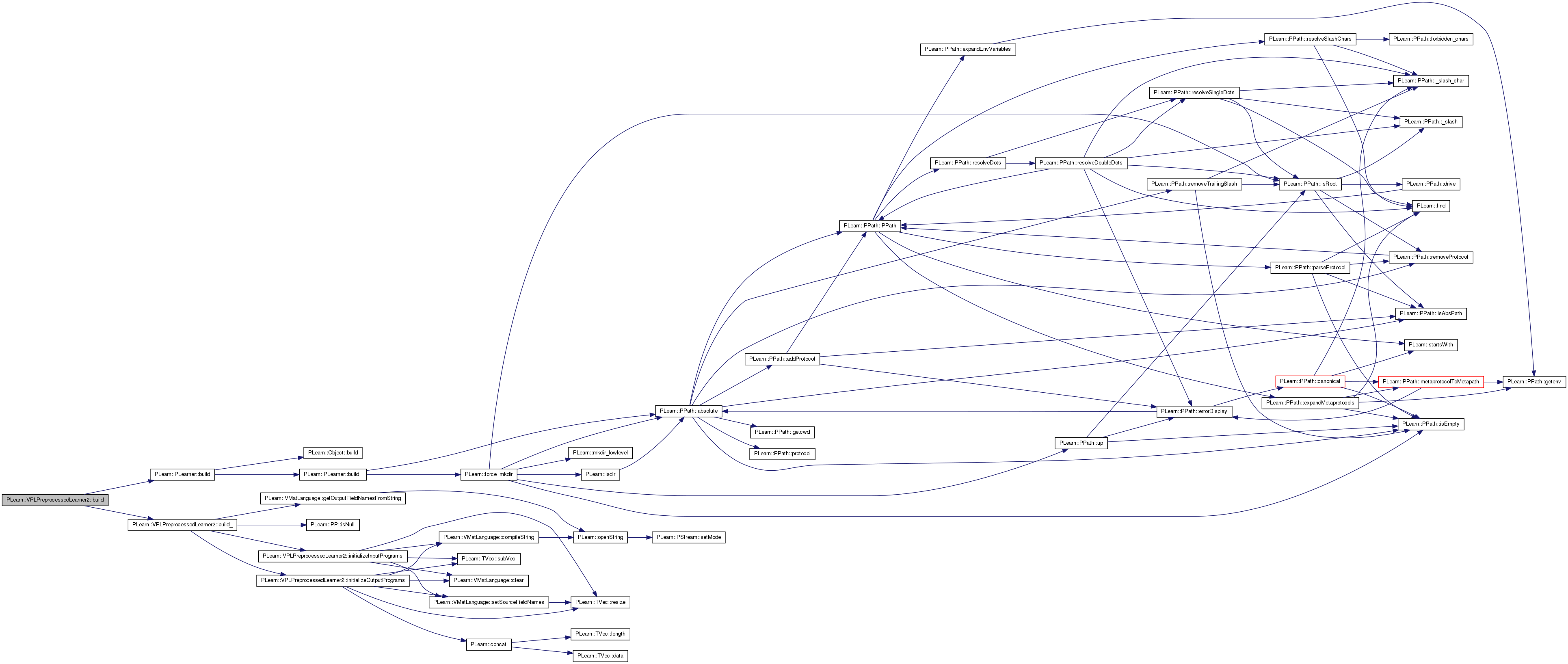
| void PLearn::VPLPreprocessedLearner2::build_ | ( | ) | [private] |
This does the actual building.
Reimplemented from PLearn::PLearner.
Definition at line 161 of file VPLPreprocessedLearner2.cc.
References costs_prg, costs_prg_fieldnames, PLearn::VMatLanguage::getOutputFieldNamesFromString(), initializeInputPrograms(), initializeOutputPrograms(), PLearn::PP< T >::isNull(), orig_inputsize, orig_targetsize, and PLearn::PLearner::train_set.
Referenced by build().
{
if(train_set.isNull() && (orig_inputsize>0 || orig_targetsize>0) ) // we're probably reloading a saved VPLPreprocessedLearner2
{
initializeInputPrograms();
initializeOutputPrograms();
}
else if(!costs_prg.empty())
VMatLanguage::getOutputFieldNamesFromString(costs_prg, costs_prg_fieldnames);
}


| string PLearn::VPLPreprocessedLearner2::classname | ( | ) | const [virtual] |
Reimplemented from PLearn::Object.
Definition at line 67 of file VPLPreprocessedLearner2.cc.
| bool PLearn::VPLPreprocessedLearner2::computeConfidenceFromOutput | ( | const Vec & | input, |
| const Vec & | output, | ||
| real | probability, | ||
| TVec< pair< real, real > > & | intervals | ||
| ) | const [virtual] |
Compute a confidence intervals for the output, given the input and the pre-computed output (resulting from computeOutput or similar).
The probability level of the confidence interval must be specified. (e.g. 0.95). Result is stored in a TVec of pairs low:high for each output variable (this is a "box" interval; it does not account for correlations among the output variables).
If the interval can be computed, the function returns TRUE; otherwise (i.e. interval computation is not available), it returns FALSE. The default implementation in PLearner is to return FALSE (with missing values in the returned intervals).
output_prg_) // output is already the output of the underlying learner
Reimplemented from PLearn::PLearner.
Definition at line 529 of file VPLPreprocessedLearner2.cc.
References PLearn::concat(), d, PLearn::TVec< T >::first(), input_prg, input_prg_, input_prg_fieldnames, learner_, PLearn::TVec< T >::length(), MISSING_VALUE, output_prg, output_prg_, outputsize(), PLASSERT, PLERROR, pre_output, processed_input, PLearn::TVec< T >::resize(), and PLearn::VMatLanguage::run().
{
int d = outputsize();
if(d!=output.length())
PLERROR("In VPLPreprocessedLearner2::computeConfidenceFromOutput, length of passed output (%d)"
"differes from outputsize (%d)!",output.length(),d);
PLASSERT( learner_ );
Vec newinput = input;
if(!input_prg.empty())//input_prg_)
{
processed_input.resize(input_prg_fieldnames.length());
input_prg_.run(input, processed_input);
newinput = processed_input;
}
bool status = false;
if(output_prg.empty())
status = learner_->computeConfidenceFromOutput(newinput, output, probability, intervals);
else // must recompute the output of underlying learner, and post-process returned intervals
{
learner_->computeOutput(newinput, pre_output);
TVec< pair<real,real> > pre_intervals;
status = learner_->computeConfidenceFromOutput(newinput, pre_output, probability, pre_intervals);
if(!status) // no confidence computation available
{
intervals.resize(d);
for(int k=0; k<d; k++)
intervals[k] = pair<real,real>(MISSING_VALUE,MISSING_VALUE);
}
else // postprocess low and high vectors
{
int ud = learner_->outputsize(); // dimension of underlying learner's output
// first build low and high vectors
Vec low(ud);
Vec high(ud);
for(int k=0; k<ud; k++)
{
pair<real,real> p = pre_intervals[k];
low[k] = p.first;
high[k] = p.second;
}
Vec post_low(d); // postprocesed low
Vec post_high(d); // postprocessed high
output_prg_.run(concat(input,low), post_low);
output_prg_.run(concat(input,high), post_high);
// Now copy post_low and post_high to intervals
intervals.resize(d);
for(int k=0; k<d; k++)
intervals[k] = pair<real,real>(post_low[k],post_high[k]);
}
}
return status;
}
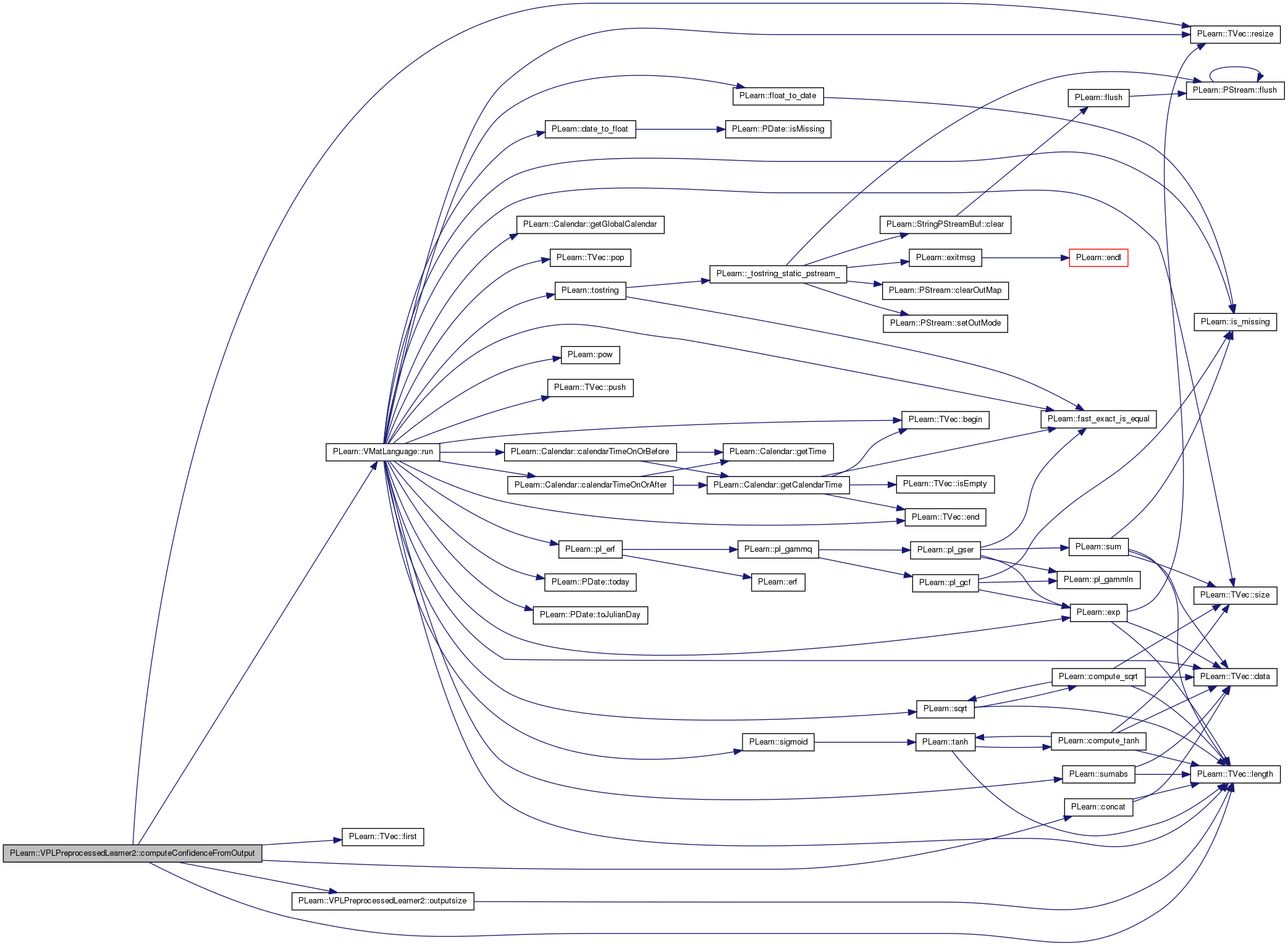
| void PLearn::VPLPreprocessedLearner2::computeCostsFromOutputs | ( | const Vec & | input, |
| const Vec & | output, | ||
| const Vec & | target, | ||
| Vec & | costs | ||
| ) | const [virtual] |
*** SUBCLASS WRITING: ***
This should be defined in subclasses to compute the weighted costs from already computed output. The costs should correspond to the cost names returned by getTestCostNames().
NOTE: In exotic cases, the cost may also depend on some info in the input, that's why the method also gets so see it.
Implements PLearn::PLearner.
Definition at line 522 of file VPLPreprocessedLearner2.cc.
References computeOutputAndCosts().
{
Vec nonconst_output = output; // to make the constipated compiler happy
computeOutputAndCosts(input, target, nonconst_output, costs);
}
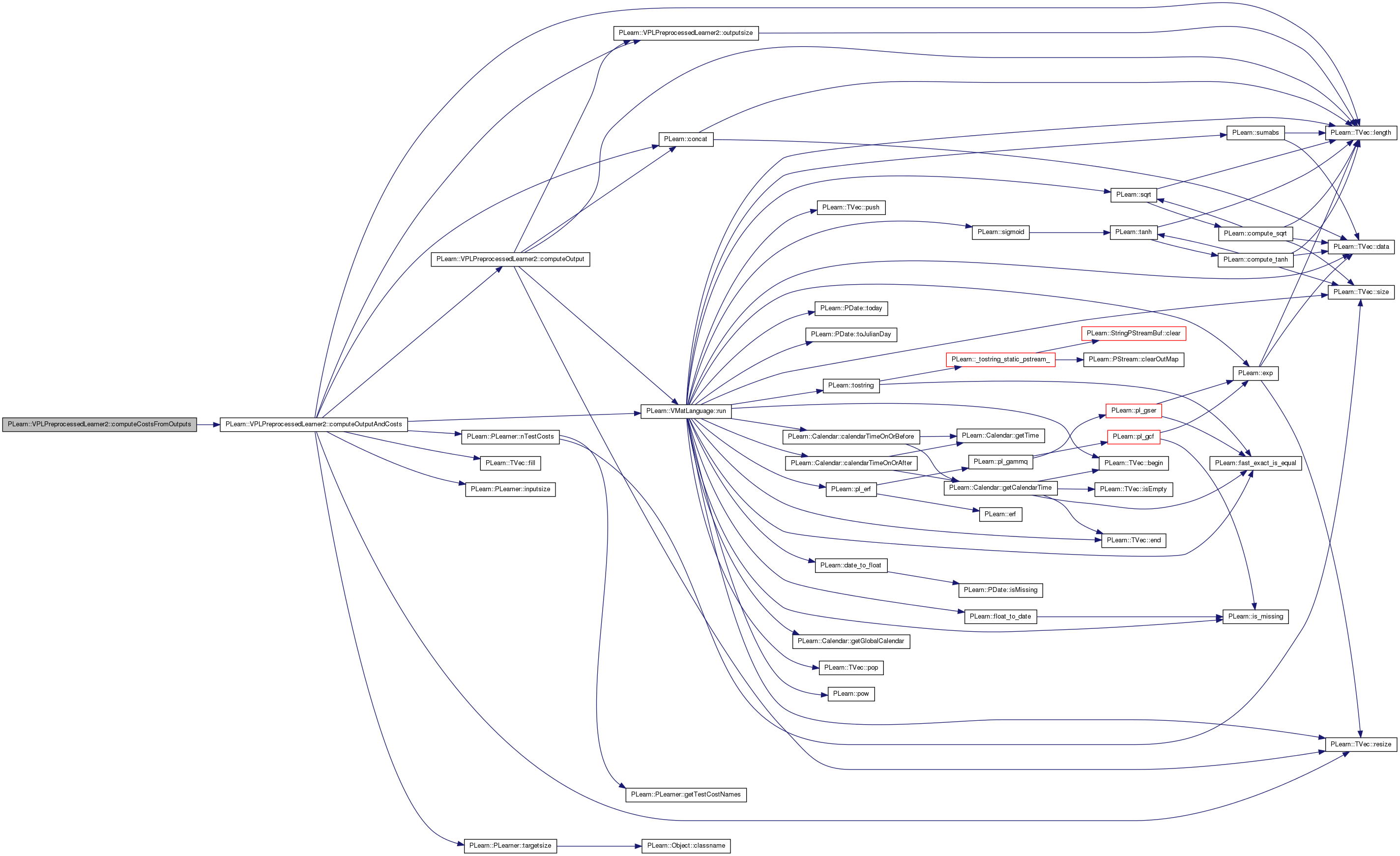
| void PLearn::VPLPreprocessedLearner2::computeOutput | ( | const Vec & | input, |
| Vec & | output | ||
| ) | const [virtual] |
*** SUBCLASS WRITING: ***
This should be defined in subclasses to compute the output from the input.
Reimplemented from PLearn::PLearner.
Definition at line 449 of file VPLPreprocessedLearner2.cc.
References PLearn::concat(), input_prg, input_prg_, input_prg_fieldnames, learner_, PLearn::TVec< T >::length(), output_prg, output_prg_, outputsize(), PLASSERT, pre_output, processed_input, PLearn::TVec< T >::resize(), and PLearn::VMatLanguage::run().
Referenced by computeOutputAndCosts().
{
PLASSERT( learner_ );
output.resize(outputsize());
Vec newinput = input;
if(!input_prg.empty())
{
processed_input.resize(input_prg_fieldnames.length());
input_prg_.run(input, processed_input);
newinput = processed_input;
}
if(!output_prg.empty())
{
learner_->computeOutput(newinput, pre_output);
// as context for output postproc
output_prg_.run(concat(input,pre_output), output);
}
else
learner_->computeOutput(newinput, output);
}
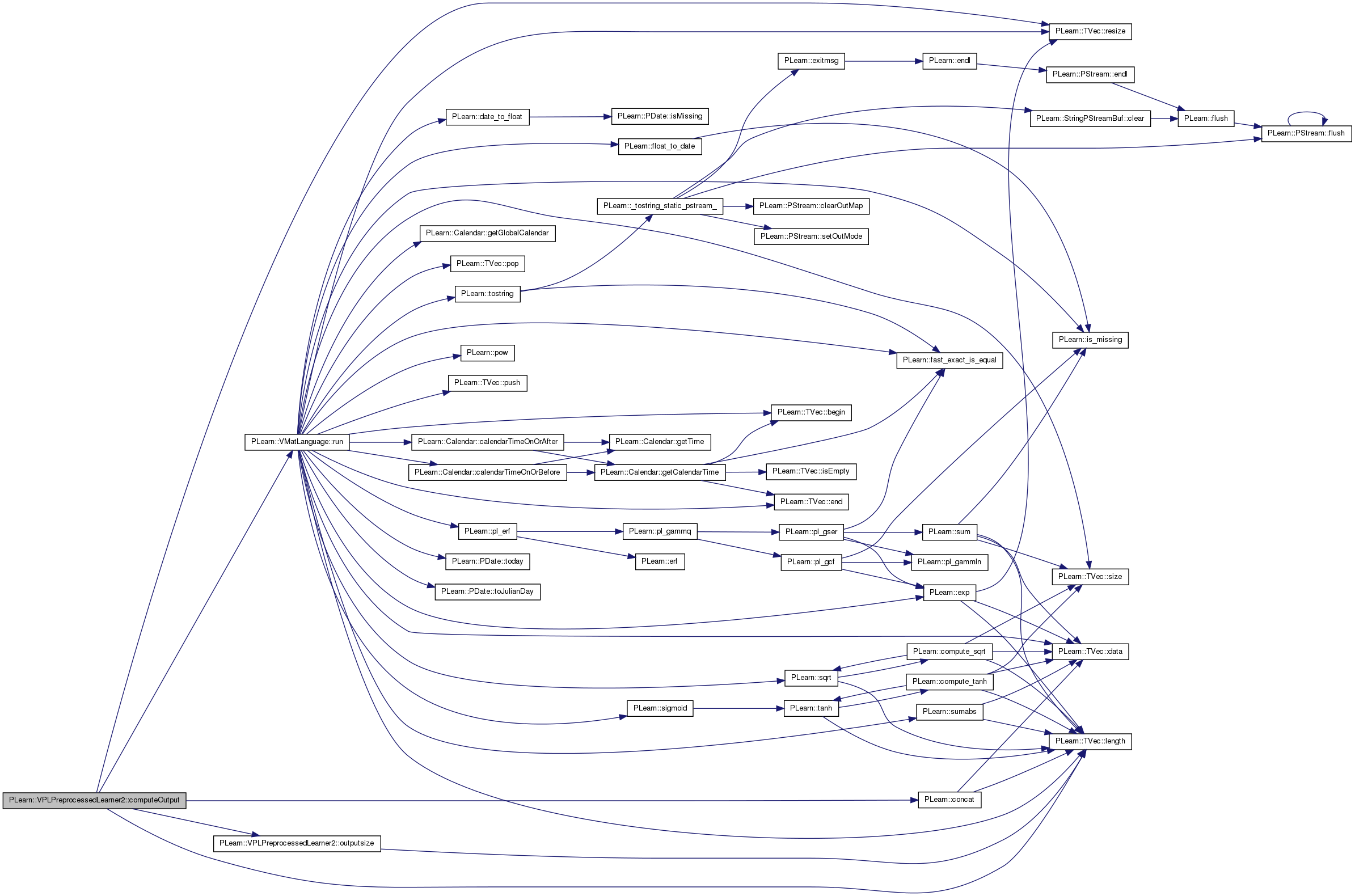

| void PLearn::VPLPreprocessedLearner2::computeOutputAndCosts | ( | const Vec & | input, |
| const Vec & | target, | ||
| Vec & | output, | ||
| Vec & | costs | ||
| ) | const [virtual] |
Default calls computeOutput and computeCostsFromOutputs.
You may override this if you have a more efficient way to compute both output and weighted costs at the same time.
Reimplemented from PLearn::PLearner.
Definition at line 472 of file VPLPreprocessedLearner2.cc.
References computeOutput(), PLearn::concat(), costs_prg, costs_prg_, PLearn::TVec< T >::fill(), ignore_test_costs, input_prg, input_prg_, input_prg_fieldnames, PLearn::PLearner::inputsize(), learner_, PLearn::TVec< T >::length(), PLearn::PLearner::nTestCosts(), orig_fieldnames, output_prg, output_prg_, outputsize(), PLASSERT, pre_costs, pre_output, processed_input, processed_target, PLearn::TVec< T >::resize(), PLearn::VMatLanguage::run(), target_prg, target_prg_, target_prg_fieldnames, and PLearn::PLearner::targetsize().
Referenced by computeCostsFromOutputs().
{
output.resize(outputsize());
costs.resize(nTestCosts());
if(ignore_test_costs)
{
costs.fill(-1);
return computeOutput(input, output);
}
PLASSERT( learner_ );
PLASSERT(input.length()==inputsize());
PLASSERT(target.length()==targetsize());
Vec newinput = input;
if(!input_prg.empty())//input_prg_)
{
processed_input.resize(input_prg_fieldnames.length());
input_prg_.run(input, processed_input);
newinput = processed_input;
}
Vec orig_row = concat(input,target);
orig_row.resize(orig_fieldnames.length());
Vec newtarget = target;
if(!target_prg.empty())//target_prg_)
{
processed_target.resize(target_prg_fieldnames.length());
target_prg_.run(orig_row, processed_target);
newtarget = processed_target;
}
pre_costs.resize(learner_->nTestCosts());
learner_->computeOutputAndCosts(newinput, newtarget, pre_output, pre_costs);
if(!output_prg.empty())//output_prg_)
output_prg_.run(concat(input,pre_output), output);
else
output << pre_output;
if(!costs_prg.empty())//costs_prg_)
costs_prg_.run(concat(input,target,pre_output,pre_costs), costs);
else
costs << pre_costs;
}
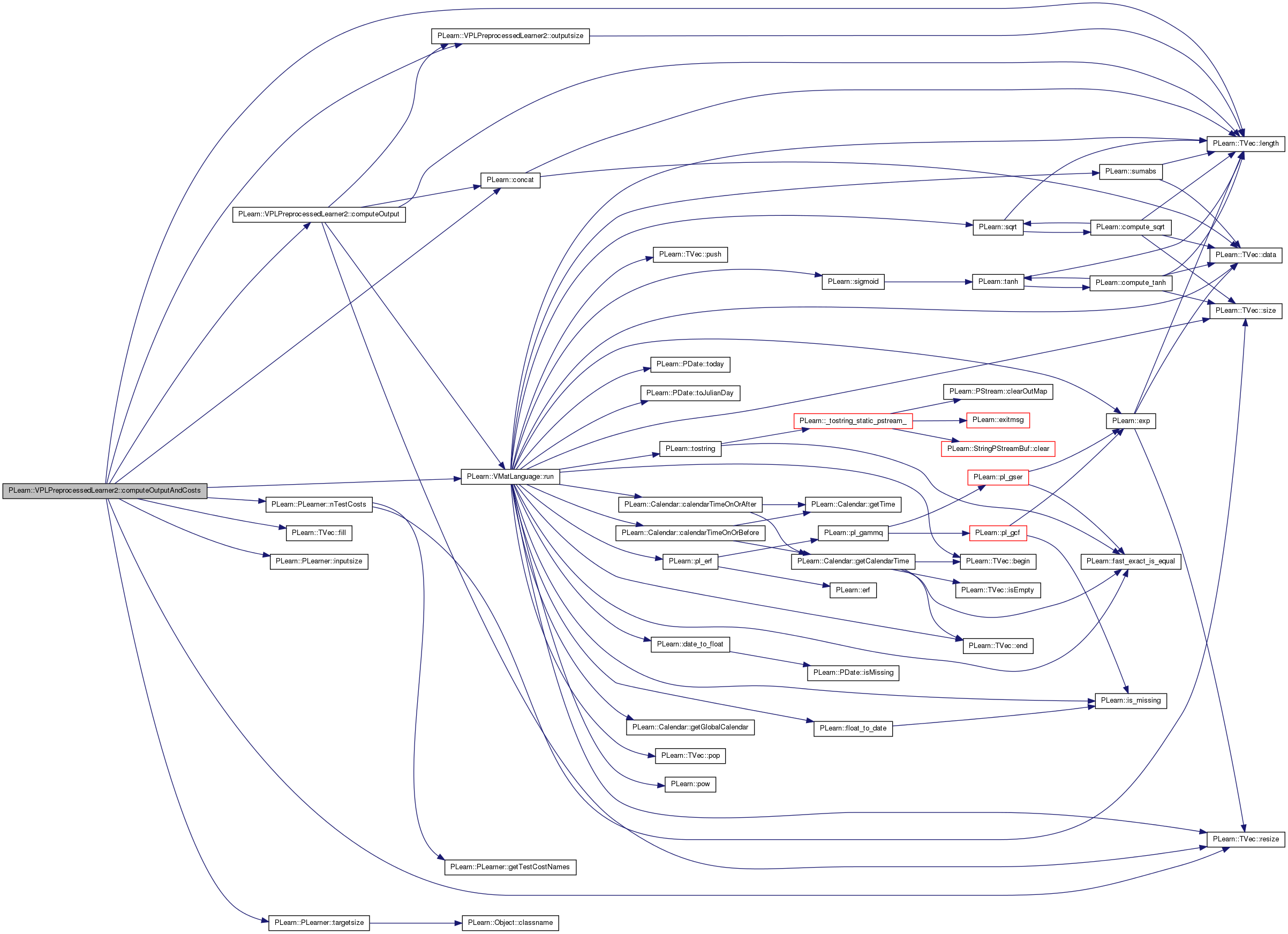

| void PLearn::VPLPreprocessedLearner2::declareOptions | ( | OptionList & | ol | ) | [static, protected] |
Declares this class' options.
Reimplemented from PLearn::PLearner.
Definition at line 69 of file VPLPreprocessedLearner2.cc.
References PLearn::OptionBase::buildoption, costs_prg, PLearn::declareOption(), PLearn::PLearner::declareOptions(), extra_prg, filtering_prg, ignore_test_costs, input_prg, learner_, PLearn::OptionBase::learntoption, orig_fieldnames, orig_inputsize, orig_targetsize, output_prg, repeat_count_field_name, repeat_id_field_name, target_prg, use_filtering_prg_for_repeat, and weight_prg.
{
// ### Declare all of this object's options here
// ### For the "flags" of each option, you should typically specify
// ### one of OptionBase::buildoption, OptionBase::learntoption or
// ### OptionBase::tuningoption. Another possible flag to be combined with
// ### is OptionBase::nosave
// ### ex:
// declareOption(ol, "myoption", &VPLPreprocessedLearner2::myoption, OptionBase::buildoption,
// "Help text describing this option");
// ...
declareOption(ol, "learner", &VPLPreprocessedLearner2::learner_,
OptionBase::buildoption,
"The embedded learner");
declareOption(ol, "filtering_prg", &VPLPreprocessedLearner2::filtering_prg, OptionBase::buildoption,
"Optional program string in VPL language to apply as filtering on the training VMat.\n"
"It's the resulting filtered training set that is passed to the underlying learner.\n"
"This program is to produce a single value interpreted as a boolean: only the rows for which\n"
"it evaluates to non-zero will be kept.\n"
"An empty string means NO FILTERING.");
declareOption(ol, "input_prg", &VPLPreprocessedLearner2::input_prg, OptionBase::buildoption,
"Program string in VPL language to be applied to each raw input \n"
"to generate the new preprocessed input.\n"
"Note that names must be given to the generated values with :fieldname VPL syntax.\n"
"An empty string means NO PREPROCESSING. (initial raw input is used as is)");
declareOption(ol, "target_prg", &VPLPreprocessedLearner2::target_prg, OptionBase::buildoption,
"Program string in VPL language to be applied to a dataset row\n"
"to generate a proper target for the underlying learner.\n"
"Note that names must be given to the generated values with :fieldname VPL syntax.\n"
"If it's an empty string, then we'll use the original target from the data set");
declareOption(ol, "weight_prg", &VPLPreprocessedLearner2::weight_prg, OptionBase::buildoption,
"Program string in VPL language to be applied to a dataset row\n"
"to generate a proper weight for the underlying learner.\n"
"Note that names must be given to the generated values with :fieldname VPL syntax.\n"
"If it's an empty string, then we'll use the original weight from the data set");
declareOption(ol, "extra_prg", &VPLPreprocessedLearner2::extra_prg, OptionBase::buildoption,
"Program string in VPL language to be applied to a dataset row\n"
"to generate proper extra fields for the underlying learner.\n"
"Note that names must be given to the generated values with :fieldname VPL syntax.\n"
"If it's an empty string, then we'll use the original extra fields from the data set");
declareOption(ol, "output_prg", &VPLPreprocessedLearner2::output_prg, OptionBase::buildoption,
"Program string in VPL language to obtain postprocessed output\n"
"from a concatenation of the raw input fields and the underlying learner's outputs\n"
"The underlying learner's outputs are typically named out0, out1, out2, ...\n"
"Note that outputnames must be given to the generated values with :fieldname VPL syntax.\n"
"If it's an empty string, then we'll output the underlying learner's outputs.\n");
declareOption(ol, "costs_prg", &VPLPreprocessedLearner2::costs_prg, OptionBase::buildoption,
"Program string in VPL language to obtain postprocessed test costs\n"
"from a concatenation of the raw input fields and target fields, \n"
"and the underlying learner's outputs and test costs.\n"
"Note that names must be given to the generated values with :fieldname VPL syntax.\n"
"If it's an empty string, then we'll output the underlying learner's test costs.\n"
"Note that this processing is only applied to test costs, not to train costs which are returned as is.");
declareOption(ol, "orig_fieldnames", &VPLPreprocessedLearner2::orig_fieldnames, OptionBase::learntoption,
"original fieldnames of the training set");
declareOption(ol, "orig_inputsize", &VPLPreprocessedLearner2::orig_inputsize, OptionBase::learntoption,
"original inputsize of the training set");
declareOption(ol, "orig_targetsize", &VPLPreprocessedLearner2::orig_targetsize, OptionBase::learntoption,
"original targetsize of the training set");
declareOption(ol, "use_filtering_prg_for_repeat", &VPLPreprocessedLearner2::use_filtering_prg_for_repeat, OptionBase::buildoption,
"When true, the result of the filtering program indicates the number of times a row should be repeated (0..n).\n"
"(sets FilteredVMatrix::allow_repeat_rows.)");
declareOption(ol, "repeat_id_field_name", &VPLPreprocessedLearner2::repeat_id_field_name, OptionBase::buildoption,
"Field name for the repetition id (0, 1, ..., n-1). No field is added if empty.");
declareOption(ol, "repeat_count_field_name", &VPLPreprocessedLearner2::repeat_count_field_name, OptionBase::buildoption,
"Field name for the number of repetitions (n). No field is added if empty.");
declareOption(ol, "ignore_test_costs", &VPLPreprocessedLearner2::ignore_test_costs, OptionBase::buildoption,
"WARNING: THIS IS AN UGLY HACK!!\n"
"When set to true, computeOutputAndCosts will simply call computeOutput and return bogus costs.");
// Now call the parent class' declareOptions
inherited::declareOptions(ol);
}

| static const PPath& PLearn::VPLPreprocessedLearner2::declaringFile | ( | ) | [inline, static] |
Reimplemented from PLearn::PLearner.
Definition at line 157 of file VPLPreprocessedLearner2.h.
| VPLPreprocessedLearner2 * PLearn::VPLPreprocessedLearner2::deepCopy | ( | CopiesMap & | copies | ) | const [virtual] |
Reimplemented from PLearn::PLearner.
Definition at line 67 of file VPLPreprocessedLearner2.cc.
| void PLearn::VPLPreprocessedLearner2::forget | ( | ) | [virtual] |
Forwarded to inner learner.
Reimplemented from PLearn::PLearner.
Definition at line 244 of file VPLPreprocessedLearner2.cc.
References learner_, PLASSERT, and PLearn::PLearner::stage.
| OptionList & PLearn::VPLPreprocessedLearner2::getOptionList | ( | ) | const [virtual] |
Reimplemented from PLearn::Object.
Definition at line 67 of file VPLPreprocessedLearner2.cc.
| OptionMap & PLearn::VPLPreprocessedLearner2::getOptionMap | ( | ) | const [virtual] |
Reimplemented from PLearn::Object.
Definition at line 67 of file VPLPreprocessedLearner2.cc.
| TVec< string > PLearn::VPLPreprocessedLearner2::getOutputNames | ( | ) | const [virtual] |
If there's an output_prg, it returns output_prg_fieldnames If there's no output_prg, the call is forwarded to the inner learner.
Reimplemented from PLearn::PLearner.
Definition at line 588 of file VPLPreprocessedLearner2.cc.
References learner_, output_prg, and output_prg_fieldnames.
{
if(!output_prg.empty())//output_prg_)
return output_prg_fieldnames;
else
return learner_->getOutputNames();
}
| RemoteMethodMap & PLearn::VPLPreprocessedLearner2::getRemoteMethodMap | ( | ) | const [virtual] |
Reimplemented from PLearn::Object.
Definition at line 67 of file VPLPreprocessedLearner2.cc.
| TVec< string > PLearn::VPLPreprocessedLearner2::getTestCostNames | ( | ) | const [virtual] |
*** SUBCLASS WRITING: ***
This should return the names of the costs computed by computeCostsFromOutputs.
Implements PLearn::PLearner.
Definition at line 597 of file VPLPreprocessedLearner2.cc.
References costs_prg, costs_prg_fieldnames, and learner_.
{
if(!costs_prg.empty())//costs_prg_)
return costs_prg_fieldnames;
else
return learner_->getTestCostNames();
}
| TVec< string > PLearn::VPLPreprocessedLearner2::getTrainCostNames | ( | ) | const [virtual] |
Forwarded to inner learner.
Implements PLearn::PLearner.
Definition at line 605 of file VPLPreprocessedLearner2.cc.
| void PLearn::VPLPreprocessedLearner2::initializeInputPrograms | ( | ) | [private] |
Definition at line 258 of file VPLPreprocessedLearner2.cc.
References PLearn::VMatLanguage::clear(), PLearn::VMatLanguage::compileString(), extra_prg, extra_prg_, extra_prg_fieldnames, ignore_test_costs, input_prg, input_prg_, input_prg_fieldnames, orig_fieldnames, orig_inputsize, PLearn::TVec< T >::resize(), PLearn::VMatLanguage::setSourceFieldNames(), PLearn::TVec< T >::subVec(), target_prg, target_prg_, target_prg_fieldnames, weight_prg, weight_prg_, and weight_prg_fieldnames.
Referenced by build_(), and setTrainingSet().
{
if(!input_prg.empty())
{
input_prg_.setSourceFieldNames(orig_fieldnames.subVec(0,orig_inputsize));
input_prg_.compileString(input_prg, input_prg_fieldnames);
}
else
{
input_prg_.clear();
input_prg_fieldnames.resize(0);
}
if(!target_prg.empty() && !ignore_test_costs)
{
target_prg_.setSourceFieldNames(orig_fieldnames);
target_prg_.compileString(target_prg, target_prg_fieldnames);
}
else
{
target_prg_.clear();
target_prg_fieldnames.resize(0);
}
if(!weight_prg.empty() && !ignore_test_costs)
{
weight_prg_.setSourceFieldNames(orig_fieldnames);
weight_prg_.compileString(weight_prg, weight_prg_fieldnames);
}
else
{
weight_prg_.clear();
weight_prg_fieldnames.resize(0);
}
if(!extra_prg.empty())
{
extra_prg_.setSourceFieldNames(orig_fieldnames);
extra_prg_.compileString(extra_prg, extra_prg_fieldnames);
}
else
{
extra_prg_.clear();
extra_prg_fieldnames.resize(0);
}
}


| void PLearn::VPLPreprocessedLearner2::initializeOutputPrograms | ( | ) | [private] |
Definition at line 306 of file VPLPreprocessedLearner2.cc.
References PLearn::VMatLanguage::clear(), PLearn::VMatLanguage::compileString(), PLearn::concat(), costs_prg, costs_prg_, costs_prg_fieldnames, learner_, orig_fieldnames, orig_inputsize, orig_targetsize, output_prg, output_prg_, output_prg_fieldnames, PLearn::TVec< T >::resize(), PLearn::VMatLanguage::setSourceFieldNames(), and PLearn::TVec< T >::subVec().
Referenced by build_(), and setTrainingSet().
{
TVec<string> orig_input_fieldnames = orig_fieldnames.subVec(0,orig_inputsize);
TVec<string> orig_target_fieldnames = orig_fieldnames.subVec(orig_inputsize, orig_targetsize);
if(!output_prg.empty())
{
output_prg_.setSourceFieldNames(concat(orig_input_fieldnames,learner_->getOutputNames()) );
output_prg_.compileString(output_prg, output_prg_fieldnames);
}
else
{
output_prg_.clear();
output_prg_fieldnames.resize(0);
}
if(!costs_prg.empty())
{
costs_prg_.setSourceFieldNames(concat(orig_input_fieldnames,orig_target_fieldnames,learner_->getOutputNames(),learner_->getTestCostNames()) );
costs_prg_.compileString(costs_prg, costs_prg_fieldnames);
}
else
{
costs_prg_.clear();
costs_prg_fieldnames.resize(0);
}
}


| bool PLearn::VPLPreprocessedLearner2::isStatefulLearner | ( | ) | const [virtual] |
Forwarded to inner learner.
Reimplemented from PLearn::PLearner.
Definition at line 617 of file VPLPreprocessedLearner2.cc.
| void PLearn::VPLPreprocessedLearner2::makeDeepCopyFromShallowCopy | ( | CopiesMap & | copies | ) | [virtual] |
Transforms a shallow copy into a deep copy.
Reimplemented from PLearn::PLearner.
Definition at line 180 of file VPLPreprocessedLearner2.cc.
References costs_prg_, costs_prg_fieldnames, PLearn::deepCopyField(), extra_prg_, extra_prg_fieldnames, input_prg_, input_prg_fieldnames, learner_, PLearn::VMatLanguage::makeDeepCopyFromShallowCopy(), PLearn::PLearner::makeDeepCopyFromShallowCopy(), output_prg_, output_prg_fieldnames, pre_costs, pre_output, processed_extra, processed_input, processed_target, processed_weight, row, target_prg_, target_prg_fieldnames, weight_prg_, and weight_prg_fieldnames.
{
inherited::makeDeepCopyFromShallowCopy(copies);
// ### Call deepCopyField on all "pointer-like" fields
// ### that you wish to be deepCopied rather than
// ### shallow-copied.
deepCopyField(learner_, copies);
input_prg_.makeDeepCopyFromShallowCopy(copies);
target_prg_.makeDeepCopyFromShallowCopy(copies);
weight_prg_.makeDeepCopyFromShallowCopy(copies);
extra_prg_.makeDeepCopyFromShallowCopy(copies);
output_prg_.makeDeepCopyFromShallowCopy(copies);
costs_prg_.makeDeepCopyFromShallowCopy(copies);
deepCopyField(input_prg_fieldnames, copies);
deepCopyField(target_prg_fieldnames, copies);
deepCopyField(weight_prg_fieldnames, copies);
deepCopyField(extra_prg_fieldnames, copies);
deepCopyField(output_prg_fieldnames, copies);
deepCopyField(costs_prg_fieldnames, copies);
deepCopyField(row, copies);
deepCopyField(processed_input, copies);
deepCopyField(processed_target, copies);
deepCopyField(processed_weight, copies);
deepCopyField(processed_extra, copies);
deepCopyField(pre_output, copies);
deepCopyField(pre_costs, copies);
}

| int PLearn::VPLPreprocessedLearner2::outputsize | ( | ) | const [virtual] |
SUBCLASS WRITING: override this so that it returns the size of this learner's output, as a function of its inputsize(), targetsize() and set options.
Implements PLearn::PLearner.
Definition at line 226 of file VPLPreprocessedLearner2.cc.
References learner_, PLearn::TVec< T >::length(), output_prg, output_prg_fieldnames, and PLASSERT.
Referenced by computeConfidenceFromOutput(), computeOutput(), and computeOutputAndCosts().
{
if(!output_prg.empty())
return output_prg_fieldnames.length();
else
{
PLASSERT( learner_ );
return learner_->outputsize();
}
}


| void PLearn::VPLPreprocessedLearner2::resetInternalState | ( | ) | [virtual] |
Forwarded to inner learner.
Reimplemented from PLearn::PLearner.
Definition at line 611 of file VPLPreprocessedLearner2.cc.
| void PLearn::VPLPreprocessedLearner2::setExperimentDirectory | ( | const PPath & | the_expdir | ) | [virtual] |
Forwarded to inner learner.
Reimplemented from PLearn::PLearner.
Definition at line 237 of file VPLPreprocessedLearner2.cc.
References learner_, PLASSERT, and PLearn::PLearner::setExperimentDirectory().
{
PLASSERT( learner_ );
inherited::setExperimentDirectory(the_expdir);
learner_->setExperimentDirectory(the_expdir);
}

| void PLearn::VPLPreprocessedLearner2::setTrainingSet | ( | VMat | training_set, |
| bool | call_forget = true |
||
| ) | [virtual] |
Declares the training set.
Then calls build() and forget() if necessary. Also sets this learner's inputsize_ targetsize_ weightsize_ from those of the training_set. Note: You shouldn't have to override this in subclasses, except in maybe to forward the call to an underlying learner.
Reimplemented from PLearn::PLearner.
Definition at line 334 of file VPLPreprocessedLearner2.cc.
References extra_prg, filtering_prg, PLearn::PLearner::getExperimentDirectory(), initializeInputPrograms(), initializeOutputPrograms(), input_prg, learner_, orig_fieldnames, orig_inputsize, orig_targetsize, PLASSERT, repeat_count_field_name, repeat_id_field_name, PLearn::PLearner::setTrainingSet(), target_prg, PLearn::PLearner::train_set, use_filtering_prg_for_repeat, PLearn::PLearner::verbosity, and weight_prg.
{
PLASSERT( learner_ );
bool training_set_has_changed = !train_set || !(train_set->looksTheSameAs(training_set));
if (call_forget && !training_set_has_changed)
// In this case, learner_->build() will not have been called, which may
// cause trouble if it updates data from the training set.
learner_->build();
orig_fieldnames = training_set->fieldNames();
orig_inputsize = training_set->inputsize();
orig_targetsize = training_set->targetsize();
initializeInputPrograms();
VMat filtered_trainset = training_set;
PPath filtered_trainset_metadatadir = getExperimentDirectory() / "filtered_train_set.metadata";
if(!filtering_prg.empty())
filtered_trainset = new FilteredVMatrix(training_set, filtering_prg, filtered_trainset_metadatadir, verbosity>1,
use_filtering_prg_for_repeat, repeat_id_field_name, repeat_count_field_name);
VMat processed_trainset = new ProcessingVMatrix(filtered_trainset, input_prg, target_prg, weight_prg, extra_prg);
learner_->setTrainingSet(processed_trainset, false);
inherited::setTrainingSet(training_set, call_forget); // will call forget if needed
initializeOutputPrograms();
}
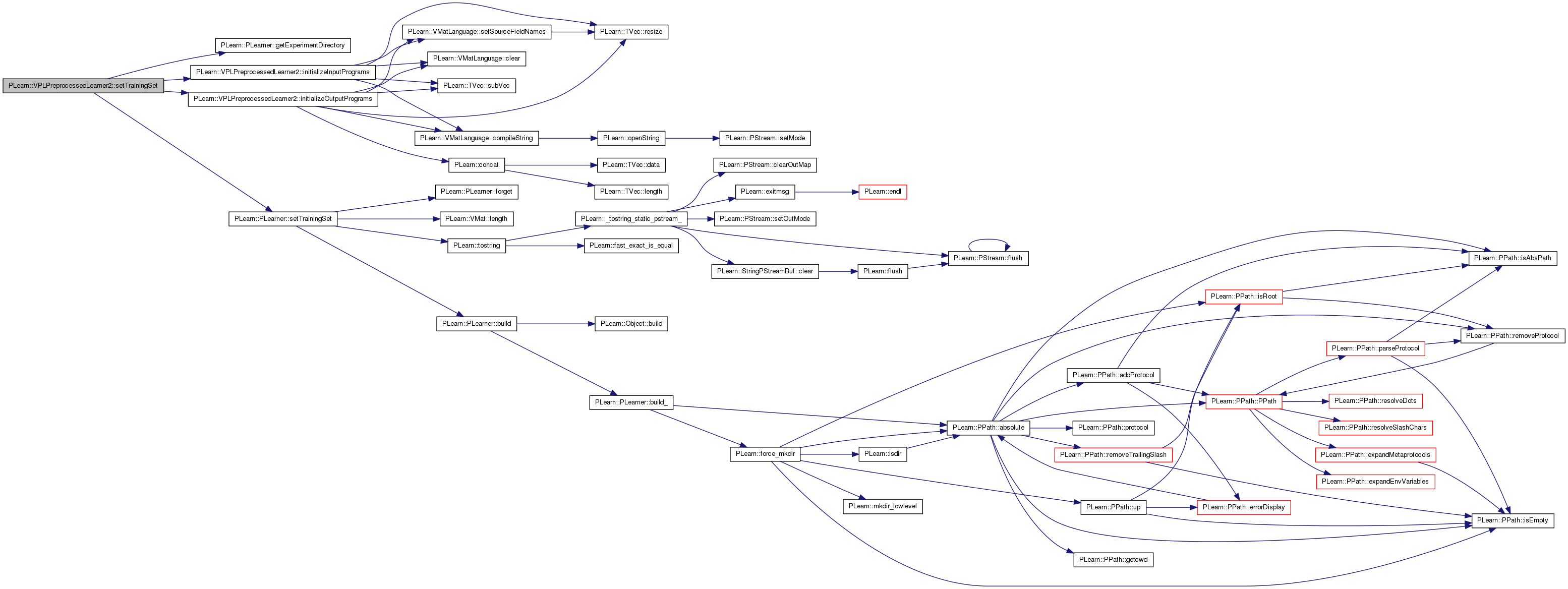
| void PLearn::VPLPreprocessedLearner2::setTrainStatsCollector | ( | PP< VecStatsCollector > | statscol | ) | [virtual] |
Forwarded to inner learner.
Reimplemented from PLearn::PLearner.
Definition at line 219 of file VPLPreprocessedLearner2.cc.
References learner_, PLASSERT, and PLearn::PLearner::setTrainStatsCollector().
{
PLASSERT( learner_ );
inherited::setTrainStatsCollector(statscol);
learner_->setTrainStatsCollector(statscol);
}

| void PLearn::VPLPreprocessedLearner2::setValidationSet | ( | VMat | validset | ) | [virtual] |
Forwarded to inner learner.
Reimplemented from PLearn::PLearner.
Definition at line 212 of file VPLPreprocessedLearner2.cc.
References learner_, PLASSERT, and PLearn::PLearner::setValidationSet().
{
PLASSERT( learner_ );
inherited::setValidationSet(validset);
learner_->setValidationSet(validset);
}

| void PLearn::VPLPreprocessedLearner2::train | ( | ) | [virtual] |
*** SUBCLASS WRITING: ***
The role of the train method is to bring the learner up to stage==nstages, updating the stats with training costs measured on-line in the process.
TYPICAL CODE:
static Vec input; // static so we don't reallocate/deallocate memory each time... static Vec target; // (but be careful that static means shared!) input.resize(inputsize()); // the train_set's inputsize() target.resize(targetsize()); // the train_set's targetsize() real weight; if(!train_stats) // make a default stats collector, in case there's none train_stats = new VecStatsCollector(); if(nstages<stage) // asking to revert to a previous stage! forget(); // reset the learner to stage=0 while(stage<nstages) { // clear statistics of previous epoch train_stats->forget(); //... train for 1 stage, and update train_stats, // using train_set->getSample(input, target, weight); // and train_stats->update(train_costs) ++stage; train_stats->finalize(); // finalize statistics for this epoch }
Implements PLearn::PLearner.
Definition at line 251 of file VPLPreprocessedLearner2.cc.
References learner_, PLASSERT, and PLearn::PLearner::stage.
Reimplemented from PLearn::PLearner.
Definition at line 157 of file VPLPreprocessedLearner2.h.
Definition at line 110 of file VPLPreprocessedLearner2.h.
Referenced by build_(), computeOutputAndCosts(), declareOptions(), getTestCostNames(), and initializeOutputPrograms().
Definition at line 66 of file VPLPreprocessedLearner2.h.
Referenced by computeOutputAndCosts(), initializeOutputPrograms(), and makeDeepCopyFromShallowCopy().
TVec<string> PLearn::VPLPreprocessedLearner2::costs_prg_fieldnames [protected] |
Definition at line 73 of file VPLPreprocessedLearner2.h.
Referenced by build_(), getTestCostNames(), initializeOutputPrograms(), and makeDeepCopyFromShallowCopy().
Definition at line 107 of file VPLPreprocessedLearner2.h.
Referenced by declareOptions(), initializeInputPrograms(), and setTrainingSet().
Definition at line 64 of file VPLPreprocessedLearner2.h.
Referenced by initializeInputPrograms(), and makeDeepCopyFromShallowCopy().
TVec<string> PLearn::VPLPreprocessedLearner2::extra_prg_fieldnames [protected] |
Definition at line 71 of file VPLPreprocessedLearner2.h.
Referenced by initializeInputPrograms(), and makeDeepCopyFromShallowCopy().
Definition at line 102 of file VPLPreprocessedLearner2.h.
Referenced by declareOptions(), and setTrainingSet().
Definition at line 91 of file VPLPreprocessedLearner2.h.
Referenced by computeOutputAndCosts(), declareOptions(), and initializeInputPrograms().
Definition at line 104 of file VPLPreprocessedLearner2.h.
Referenced by computeConfidenceFromOutput(), computeOutput(), computeOutputAndCosts(), declareOptions(), initializeInputPrograms(), and setTrainingSet().
Definition at line 61 of file VPLPreprocessedLearner2.h.
Referenced by computeConfidenceFromOutput(), computeOutput(), computeOutputAndCosts(), initializeInputPrograms(), and makeDeepCopyFromShallowCopy().
TVec<string> PLearn::VPLPreprocessedLearner2::input_prg_fieldnames [protected] |
Definition at line 68 of file VPLPreprocessedLearner2.h.
Referenced by computeConfidenceFromOutput(), computeOutput(), computeOutputAndCosts(), initializeInputPrograms(), and makeDeepCopyFromShallowCopy().
Inner learner which is embedded into the current learner.
Definition at line 100 of file VPLPreprocessedLearner2.h.
Referenced by computeConfidenceFromOutput(), computeOutput(), computeOutputAndCosts(), declareOptions(), forget(), getOutputNames(), getTestCostNames(), getTrainCostNames(), initializeOutputPrograms(), isStatefulLearner(), makeDeepCopyFromShallowCopy(), outputsize(), resetInternalState(), setExperimentDirectory(), setTrainingSet(), setTrainStatsCollector(), setValidationSet(), and train().
TVec<string> PLearn::VPLPreprocessedLearner2::orig_fieldnames [protected] |
Definition at line 84 of file VPLPreprocessedLearner2.h.
Referenced by computeOutputAndCosts(), declareOptions(), initializeInputPrograms(), initializeOutputPrograms(), and setTrainingSet().
int PLearn::VPLPreprocessedLearner2::orig_inputsize [protected] |
Definition at line 85 of file VPLPreprocessedLearner2.h.
Referenced by build_(), declareOptions(), initializeInputPrograms(), initializeOutputPrograms(), and setTrainingSet().
int PLearn::VPLPreprocessedLearner2::orig_targetsize [protected] |
Definition at line 86 of file VPLPreprocessedLearner2.h.
Referenced by build_(), declareOptions(), initializeOutputPrograms(), and setTrainingSet().
Definition at line 109 of file VPLPreprocessedLearner2.h.
Referenced by computeConfidenceFromOutput(), computeOutput(), computeOutputAndCosts(), declareOptions(), getOutputNames(), initializeOutputPrograms(), and outputsize().
Definition at line 65 of file VPLPreprocessedLearner2.h.
Referenced by computeConfidenceFromOutput(), computeOutput(), computeOutputAndCosts(), initializeOutputPrograms(), and makeDeepCopyFromShallowCopy().
TVec<string> PLearn::VPLPreprocessedLearner2::output_prg_fieldnames [protected] |
Definition at line 72 of file VPLPreprocessedLearner2.h.
Referenced by getOutputNames(), initializeOutputPrograms(), makeDeepCopyFromShallowCopy(), and outputsize().
Vec PLearn::VPLPreprocessedLearner2::pre_costs [mutable, protected] |
Definition at line 78 of file VPLPreprocessedLearner2.h.
Referenced by computeOutputAndCosts(), and makeDeepCopyFromShallowCopy().
Vec PLearn::VPLPreprocessedLearner2::pre_output [mutable, protected] |
Definition at line 77 of file VPLPreprocessedLearner2.h.
Referenced by computeConfidenceFromOutput(), computeOutput(), computeOutputAndCosts(), and makeDeepCopyFromShallowCopy().
Vec PLearn::VPLPreprocessedLearner2::processed_extra [mutable, protected] |
Definition at line 76 of file VPLPreprocessedLearner2.h.
Referenced by makeDeepCopyFromShallowCopy().
Vec PLearn::VPLPreprocessedLearner2::processed_input [mutable, protected] |
Definition at line 76 of file VPLPreprocessedLearner2.h.
Referenced by computeConfidenceFromOutput(), computeOutput(), computeOutputAndCosts(), and makeDeepCopyFromShallowCopy().
Vec PLearn::VPLPreprocessedLearner2::processed_target [mutable, protected] |
Definition at line 76 of file VPLPreprocessedLearner2.h.
Referenced by computeOutputAndCosts(), and makeDeepCopyFromShallowCopy().
Vec PLearn::VPLPreprocessedLearner2::processed_weight [mutable, protected] |
Definition at line 76 of file VPLPreprocessedLearner2.h.
Referenced by makeDeepCopyFromShallowCopy().
string PLearn::VPLPreprocessedLearner2::repeat_count_field_name [protected] |
Definition at line 90 of file VPLPreprocessedLearner2.h.
Referenced by declareOptions(), and setTrainingSet().
string PLearn::VPLPreprocessedLearner2::repeat_id_field_name [protected] |
Definition at line 89 of file VPLPreprocessedLearner2.h.
Referenced by declareOptions(), and setTrainingSet().
Vec PLearn::VPLPreprocessedLearner2::row [mutable, protected] |
Definition at line 75 of file VPLPreprocessedLearner2.h.
Referenced by makeDeepCopyFromShallowCopy().
Definition at line 105 of file VPLPreprocessedLearner2.h.
Referenced by computeOutputAndCosts(), declareOptions(), initializeInputPrograms(), and setTrainingSet().
Definition at line 62 of file VPLPreprocessedLearner2.h.
Referenced by computeOutputAndCosts(), initializeInputPrograms(), and makeDeepCopyFromShallowCopy().
TVec<string> PLearn::VPLPreprocessedLearner2::target_prg_fieldnames [protected] |
Definition at line 69 of file VPLPreprocessedLearner2.h.
Referenced by computeOutputAndCosts(), initializeInputPrograms(), and makeDeepCopyFromShallowCopy().
Definition at line 88 of file VPLPreprocessedLearner2.h.
Referenced by declareOptions(), and setTrainingSet().
Definition at line 106 of file VPLPreprocessedLearner2.h.
Referenced by declareOptions(), initializeInputPrograms(), and setTrainingSet().
Definition at line 63 of file VPLPreprocessedLearner2.h.
Referenced by initializeInputPrograms(), and makeDeepCopyFromShallowCopy().
TVec<string> PLearn::VPLPreprocessedLearner2::weight_prg_fieldnames [protected] |
Definition at line 70 of file VPLPreprocessedLearner2.h.
Referenced by initializeInputPrograms(), and makeDeepCopyFromShallowCopy().
 1.7.4
1.7.4